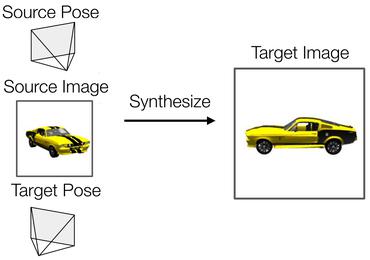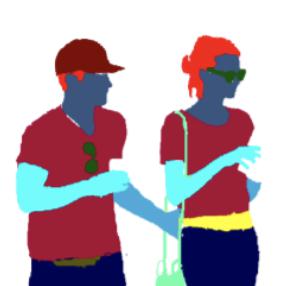Search Results for author: Yiming Gao
Found 14 papers, 4 papers with code
InstantMesh: Efficient 3D Mesh Generation from a Single Image with Sparse-view Large Reconstruction Models
2 code implementations • 10 Apr 2024 • Jiale Xu, Weihao Cheng, Yiming Gao, Xintao Wang, Shenghua Gao, Ying Shan
We present InstantMesh, a feed-forward framework for instant 3D mesh generation from a single image, featuring state-of-the-art generation quality and significant training scalability.
Advances in 3D Generation: A Survey
no code implementations • 31 Jan 2024 • Xiaoyu Li, Qi Zhang, Di Kang, Weihao Cheng, Yiming Gao, Jingbo Zhang, Zhihao Liang, Jing Liao, Yan-Pei Cao, Ying Shan
In this survey, we aim to introduce the fundamental methodologies of 3D generation methods and establish a structured roadmap, encompassing 3D representation, generation methods, datasets, and corresponding applications.
Enhancing Human Experience in Human-Agent Collaboration: A Human-Centered Modeling Approach Based on Positive Human Gain
no code implementations • 28 Jan 2024 • Yiming Gao, Feiyu Liu, Liang Wang, Zhenjie Lian, Dehua Zheng, Weixuan Wang, Wenjin Yang, Siqin Li, Xianliang Wang, Wenhui Chen, Jing Dai, Qiang Fu, Wei Yang, Lanxiao Huang, Wei Liu
We expect that agents should learn to enhance the extent to which humans achieve these goals while maintaining agents' original abilities (e. g., winning games).
Prompt Guided Copy Mechanism for Conversational Question Answering
no code implementations • 7 Aug 2023 • Yong Zhang, Zhitao Li, Jianzong Wang, Yiming Gao, Ning Cheng, Fengying Yu, Jing Xiao
Conversational Question Answering (CQA) is a challenging task that aims to generate natural answers for conversational flow questions.
Towards Effective and Interpretable Human-Agent Collaboration in MOBA Games: A Communication Perspective
no code implementations • 23 Apr 2023 • Yiming Gao, Feiyu Liu, Liang Wang, Zhenjie Lian, Weixuan Wang, Siqin Li, Xianliang Wang, Xianhan Zeng, Rundong Wang, Jiawei Wang, Qiang Fu, Wei Yang, Lanxiao Huang, Wei Liu
MOBA games, e. g., Dota2 and Honor of Kings, have been actively used as the testbed for the recent AI research on games, and various AI systems have been developed at the human level so far.
SurfelNeRF: Neural Surfel Radiance Fields for Online Photorealistic Reconstruction of Indoor Scenes
no code implementations • CVPR 2023 • Yiming Gao, Yan-Pei Cao, Ying Shan
Online reconstructing and rendering of large-scale indoor scenes is a long-standing challenge.
IDmUNet: A new image decomposition induced network for sparse feature segmentation
no code implementations • 5 Mar 2022 • Yumeng Ren, Yiming Gao, Chunlin Wu, Xue-Cheng Tai
Because of the sparsity prior and deep unfolding method in the structure design, this IDmUNet combines the advantages of mathematical modeling and data-driven approaches.
Learning Diverse Policies in MOBA Games via Macro-Goals
no code implementations • NeurIPS 2021 • Yiming Gao, Bei Shi, Xueying Du, Liang Wang, Guangwei Chen, Zhenjie Lian, Fuhao Qiu, Guoan Han, Weixuan Wang, Deheng Ye, Qiang Fu, Wei Yang, Lanxiao Huang
Recently, many researchers have made successful progress in building the AI systems for MOBA-game-playing with deep reinforcement learning, such as on Dota 2 and Honor of Kings.
Graphonomy: Universal Image Parsing via Graph Reasoning and Transfer
2 code implementations • 26 Jan 2021 • Liang Lin, Yiming Gao, Ke Gong, Meng Wang, Xiaodan Liang
Prior highly-tuned image parsing models are usually studied in a certain domain with a specific set of semantic labels and can hardly be adapted into other scenarios (e. g., sharing discrepant label granularity) without extensive re-training.
Ada-Segment: Automated Multi-loss Adaptation for Panoptic Segmentation
no code implementations • 7 Dec 2020 • Gengwei Zhang, Yiming Gao, Hang Xu, Hao Zhang, Zhenguo Li, Xiaodan Liang
Panoptic segmentation that unifies instance segmentation and semantic segmentation has recently attracted increasing attention.
 Ranked #17 on
Panoptic Segmentation
on COCO test-dev
Ranked #17 on
Panoptic Segmentation
on COCO test-dev
Bidirectional Graph Reasoning Network for Panoptic Segmentation
no code implementations • CVPR 2020 • Yangxin Wu, Gengwei Zhang, Yiming Gao, Xiajun Deng, Ke Gong, Xiaodan Liang, Liang Lin
We introduce a Bidirectional Graph Reasoning Network (BGRNet), which incorporates graph structure into the conventional panoptic segmentation network to mine the intra-modular and intermodular relations within and between foreground things and background stuff classes.
Fashion Retrieval via Graph Reasoning Networks on a Similarity Pyramid
no code implementations • ICCV 2019 • Zhanghui Kuang, Yiming Gao, Guanbin Li, Ping Luo, Yimin Chen, Liang Lin, Wayne Zhang
To address this issue, we propose a novel Graph Reasoning Network (GRNet) on a Similarity Pyramid, which learns similarities between a query and a gallery cloth by using both global and local representations in multiple scales.
 Ranked #4 on
Image Retrieval
on DeepFashion - Consumer-to-shop
(Rank-1 metric)
Ranked #4 on
Image Retrieval
on DeepFashion - Consumer-to-shop
(Rank-1 metric)
Graphonomy: Universal Human Parsing via Graph Transfer Learning
1 code implementation • CVPR 2019 • Ke Gong, Yiming Gao, Xiaodan Liang, Xiaohui Shen, Meng Wang, Liang Lin
By distilling universal semantic graph representation to each specific task, Graphonomy is able to predict all levels of parsing labels in one system without piling up the complexity.
Deep Neural Networks Improve Radiologists' Performance in Breast Cancer Screening
2 code implementations • 20 Mar 2019 • Nan Wu, Jason Phang, Jungkyu Park, Yiqiu Shen, Zhe Huang, Masha Zorin, Stanisław Jastrzębski, Thibault Févry, Joe Katsnelson, Eric Kim, Stacey Wolfson, Ujas Parikh, Sushma Gaddam, Leng Leng Young Lin, Kara Ho, Joshua D. Weinstein, Beatriu Reig, Yiming Gao, Hildegard Toth, Kristine Pysarenko, Alana Lewin, Jiyon Lee, Krystal Airola, Eralda Mema, Stephanie Chung, Esther Hwang, Naziya Samreen, S. Gene Kim, Laura Heacock, Linda Moy, Kyunghyun Cho, Krzysztof J. Geras
We present a deep convolutional neural network for breast cancer screening exam classification, trained and evaluated on over 200, 000 exams (over 1, 000, 000 images).









